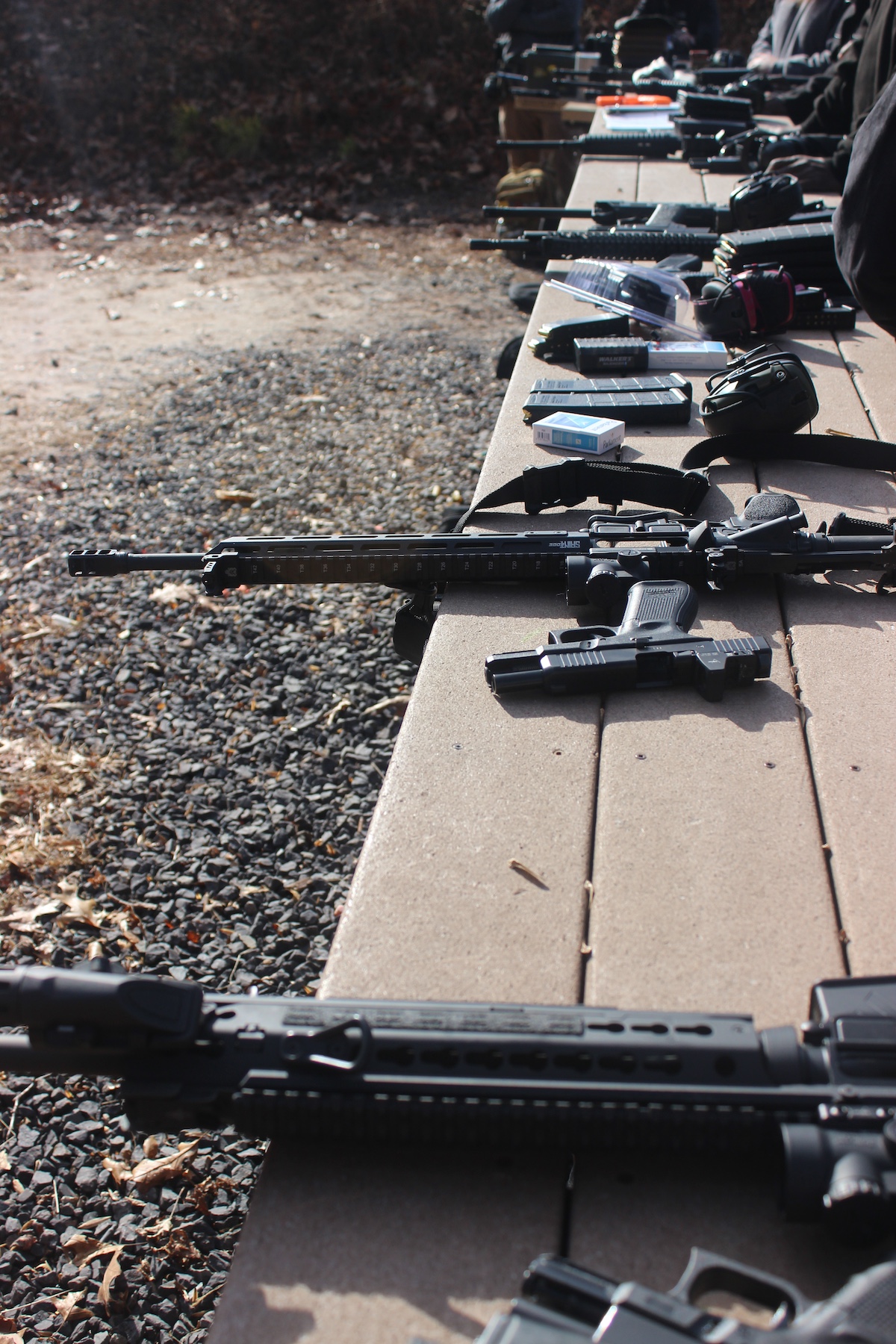WATCH WHAT YOU FEED YOUR GUN

Cajun Arms Firearms training
Watch What You Feed Your Gun: Ammo Safety to Prevent Catastrophic Malfunctions
A single careless choice at the loading table can destroy a rifle, injure people, and cost thousands in repairs. At Cajun Arms in West Chester, PA, we teach the mechanics of the firearm and the discipline around ammunition handling—because ammo safety is firearm safety. This cautionary tale and practical checklist will help you avoid feeding the wrong cartridge to your rifle and turning a range day into a disaster.
H2 — The Cautionary Tale: One Round, One Catastrophe
A student recently bought a Tavor X95 from us. After his first range outing he brought the rifle back: the bolt was slightly retracted, brass visible, and the magazine had “blown out.” He admitted he sometimes picks up loose rounds off the deck and uses them without inspecting them.
IWI inspected the rifle and found the cause: a 300 Blackout round had been chambered in the bullpup—a platform built for .223/5.56. The 300 BLK produced pressures and dimensions incompatible with the barrel and receiver. The result was catastrophic: the receiver, bolt, and barrel were destroyed. The cartridge exited the muzzle and the rifle split out the bottom and side. Miraculously, nobody was hurt. The cost? An expensive replacement—and a permanent training scar.
H2 — Why This Happens: Caliber Confusion & Damaged Ammo
Caliber Mix-Ups Are Simple — And Devastating
Many modern owners run multiple rifles (5.56/.223 and 300 BLK are a common pair). The cartridges can look similar at a glance, and under stress or distraction it’s easy to load the wrong one. The result is a catastrophic overpressure event when a larger-diameter round is fired through a smaller bore.
Deck Ammo and Dented Rounds
Picking up “deck ammo” (loose rounds found on the range floor) is a bad habit. Rounds can be damaged, corroded, or mis-formed; they may have been fired from another gun or be the wrong caliber. Even a slightly over-seated or dented round can cause feeding problems and dangerous pressure spikes. We once had an over-seated 9mm destroy a Glock 45 during a class.
Practical Rules to Prevent Feeding Your Gun the Wrong Ammo
These are the rules we teach and enforce in our ammo safety and AR-15 maintenance classes. They’re simple, repeatable, and life-saving.
Rule 1: ALWAYS Visually Inspect Every Round Before Loading
Look for caliber markings, dents, corrosion, over-seating, and loose bullets. Don’t trust color-coding or memory—verify each round.
Rule 2: Don’t Pick Up Ammo Off the Deck
If you find a round on the range, do not load it. Place it in a bin for inspection later—if at all.
Rule 3: Use Clearly Marked Ammo Cans and Magazines
Have separate, labeled ammo cans for 5.56/.223, 300 BLK, 9mm, etc. Mark mags (and even bodies) with paint, tape, or distinct followers for each caliber.
Rule 4: Bring One Caliber at a Time (When Possible)
If you can, dedicate a trip to a single caliber. This nearly eliminates cross-loading mistakes.
Rule 5: Use Dedicated Mags or Distinct Markings for 300 BLK vs 5.56
If you run both 5.56 and 300 BLK, use different mag bodies or bright tape to indicate which is which. Mark the rifle if necessary.
Rule 6: Inspect Brass and Case Mouth Seating Before Use
Check for over-seated bullets and proper crimping. Small defects can cause high pressure or feeding issues.
Rule 7: Train With the Gear You Carry—Include Malfunction Drills
If something goes wrong, you must clear it. Train to safely clear malfunctions, and know when to stop and send the rifle to the manufacturer.
H2 — What to Do If You Suspect a Wrong Caliber or Catastrophic Issue
-
Stop firing immediately.
-
Safely clear the weapon if it can be cleared without forcing parts.
-
Don’t attempt makeshift fixes (hammers and screwdrivers can void warranties and make things worse).
-
Document what happened—take photos and note the ammo used, serial number, and lot numbers if possible.
-
Send the rifle to the manufacturer or qualified gunsmith (as we advised in the Tavor case).
-
Report near-misses to your instructor—this helps prevent future incidents.
Training & Prevention: What Cajun Arms Teaches
At Cajun Arms we incorporate ammo handling safety, AR-15 maintenance, and decision-making into our curriculum. Key elements include:
-
Live drills on caliber identification and mag marking.
-
Hands-on inspections of rounds and magazines.
-
Malfunction-clearing under supervision.
-
Best practices for range etiquette: no picking up deck ammo for immediate reuse.
-
Guidance on when to call the manufacturer (IWI in the recent case).
Our goal is to make safe ammunition handling a non-negotiable, automatic habit for every shooter.
Ready to reduce risk and shoot safely? Book an Ammo Safety & AR-15 Maintenance clinic at Cajun Arms in West Chester, PA to learn safe loading, inspection, and malfunction protocols.
Book now: https://cajunarms.com/classes
- Mental Preparation for Defensive Shooting Class
- Mental Preparation for Defensive Shooting: The Missing Link for CCW Holders
- 2025/26 Trends in CCW & Concealed Carry: What Every Responsible Gun Owner Should Know
- Mastering Speed and Precision in Defensive Pistol Training: A Complete Guide
- Why Small Unit Tactics (SUT) Don’t Work for Civilians — And What Does: A Cajun Arms Guide
- What to Expect in a Defensive Pistol Class
- Essential AR15 Maintenance Tips for Maximum Reliability and Long Service Life
- Bad Guys Come Out in the Heat
- Looking for “Firearms Training Near Me”? Here’s What to Expect—and How to Choose the Right Instructor
- Speed vs. Precision: What Matters Most in a Defensive Shooting?
- Dynamic Movement & Shooting: Train Like You Fight
- Firearms Training and Home Defense
- From Basics to Advanced: Tactical Shooting Courses at Cajun Arms
- Firearms Training Near Me - Cajun Arms West Chester, PA
- Master Your AR-15 with Expert Training at Cajun Arms
- Defensive Pistol Training for Self-Defense — Cajun Arms
- Choose the Best Home Defense Firearm — Cajun Arms Guidance
- Becoming a Firearms Instructor: The Path to Excellence
- Empowerment Through Precision: Elevating Your Self-Defense Firearm Skills
- Training Scars: Breaking Free From Flat-Range Habits
- Vehicle Defense
- WATCH WHAT YOU FEED YOUR GUN
- CAN YOU BE ACCOUNTABLE FOR YOUR SPEED?
- Training with Micro-Compacts
- A Follow Up to the “Hardest Shooting Fundamental”
- So You Want To Go Fast?
- The Hardest Shooting Fundamental: Mastering Follow-Through
- Why Are You Just Standing There? Shooting From Unconventional Positions
- New Gun, New Habits
- Home Defense Shotgun Set Up
- What Should I be Doing at the Range?
- Fighting From The Ground
- Take Charge of Recoil, don’t let it control you…
- Think Before You Speak
- Grab a Partner
- The Risks of Being Nice…
- Lead With Your Eyes (not your muzzle)
- Train as You Carry… Leave the competition and tactical gear behind
- KNIFE VS GUN - A quick scenario to ponder
- Frankengun vs. Factory: Choosing a Reliable AR for Self-Defense
- Memory - Program Yourself
- Training for Injury
- Lights and Lasers and YouTube Ninjas
- Our Stance on Your Stance
- Training for More Than One Attacker…
- Keep Your Head On - Consistency
- Defensive Shotgun Accessory Do’s and Don’ts
- Charlottesville - lies and hypocrites
- Keep Your Finger Off the Trigger…
- …and Re-holster
- Unauthorized persons…
- Focus on What will Save Your Life
- Train for Success with your Firearms
- Every Day is a Good Day to Be Ready
- Appendix Carry - Is it right for you?
- Learn to See the Light: Low-Light Firearms Training You Can Use
- Anti-Gun Sentiment on the Intarwebs…
- Avoidance and Awareness
- Point Shooting: Does it work? Do you know what it is?
- About your self-defense carry ammo...
- See the Whole Picture... Know how to reload reflexively
- One-Handed Shooting
- Every Bullet Has a Price...
- On Magazine Changes... fighting for your life
- There is Such a Thing as Too Fast...
- A Threat at Arm's Length
- In defensive shooting, missing your target has consequences...
- AR15 for Home-Defense
- Operating out of your Comfort Zone...
- Every Bullet Has A Price - Operational Speed
- Car and Truck Gun Safety: Protect Yourself Responsibly
- Keep a Clear Head
- Get Training!
- Women and Firearms at Cajun Arms

